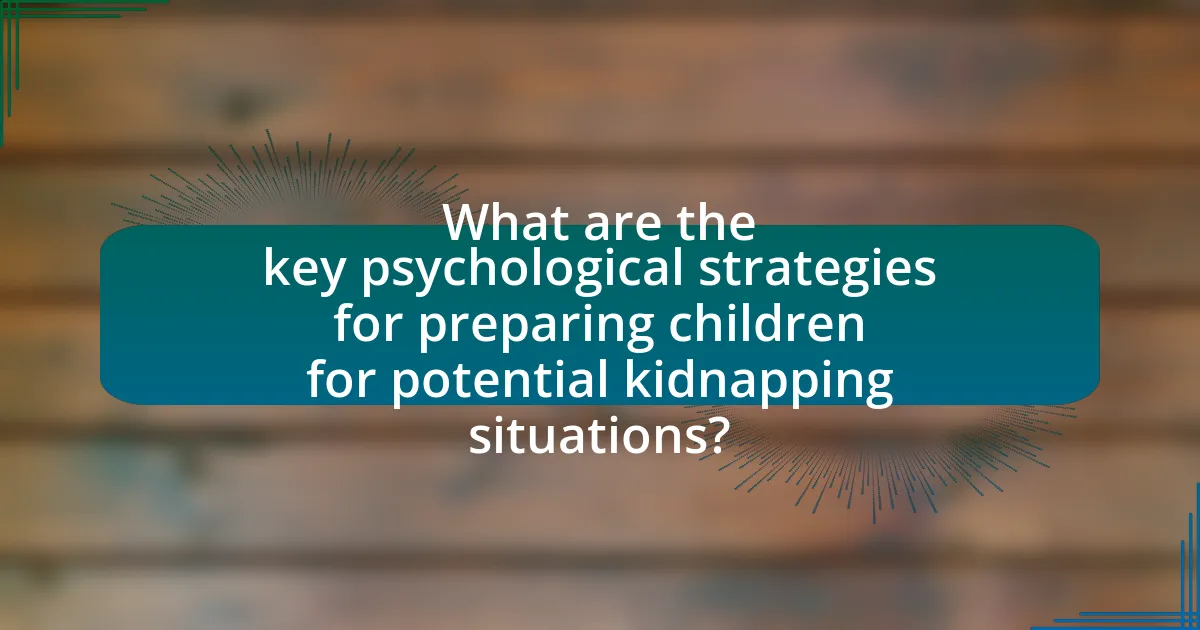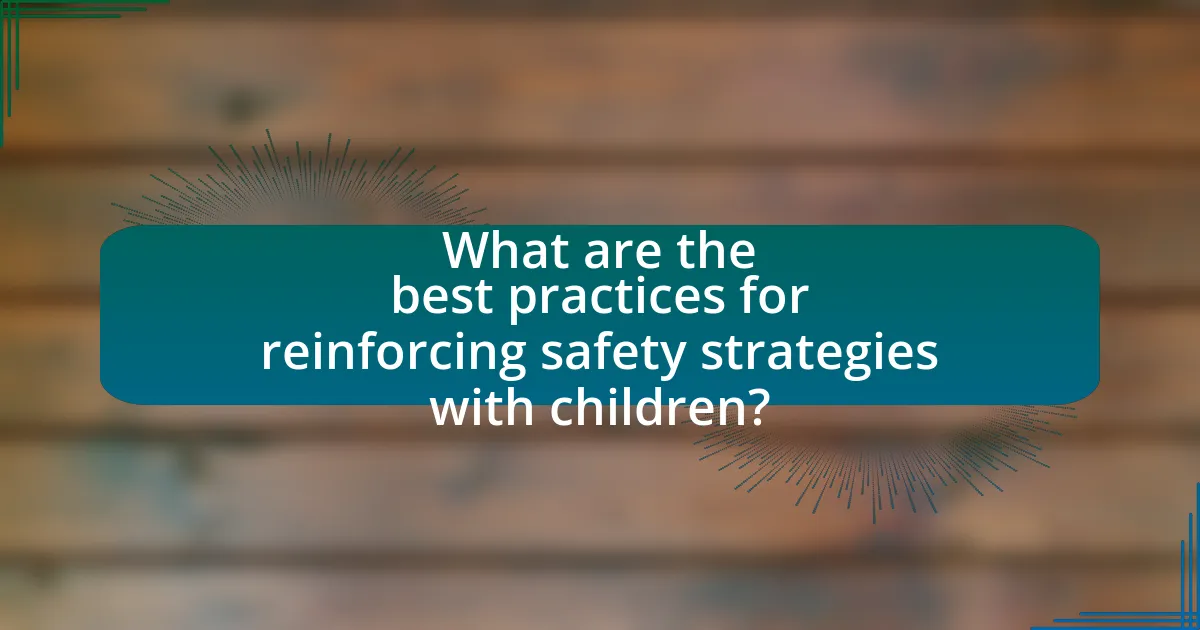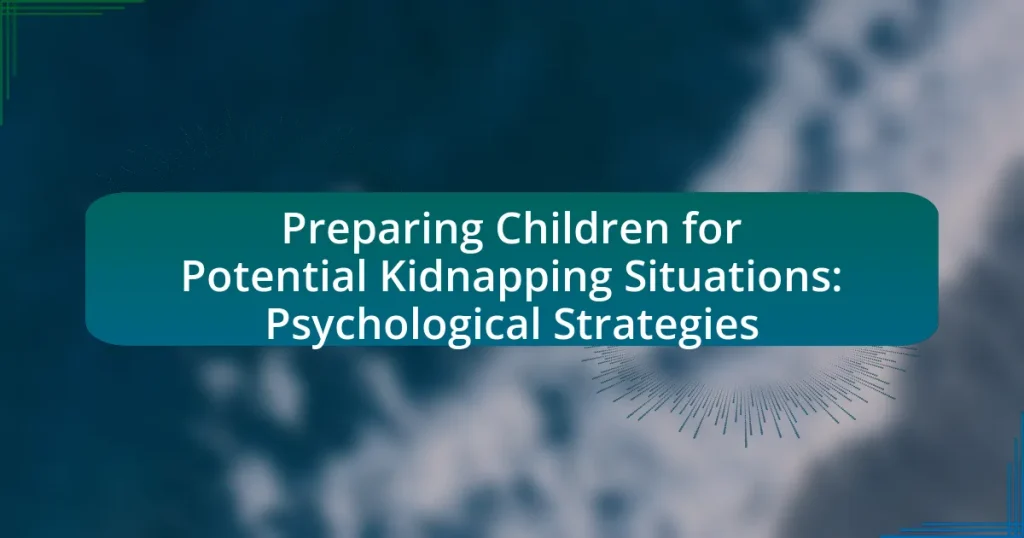The article focuses on key psychological strategies for preparing children for potential kidnapping situations. It emphasizes the importance of fostering awareness, teaching assertiveness, and encouraging open communication to help children recognize and respond to threats effectively. Parents are guided on how to communicate the dangers of kidnapping using age-appropriate language, the role of storytelling and role-playing in reinforcing safety messages, and the significance of teaching personal boundaries. Additionally, the article outlines practical tips for enhancing children’s situational awareness and provides resources for parents to educate their children about safety.

What are the key psychological strategies for preparing children for potential kidnapping situations?
Key psychological strategies for preparing children for potential kidnapping situations include fostering awareness, teaching assertiveness, and encouraging open communication. Awareness involves educating children about their surroundings and recognizing suspicious behavior, which can help them identify potential threats. Teaching assertiveness empowers children to say “no” and to seek help when they feel uncomfortable, reinforcing their ability to respond effectively in dangerous situations. Open communication creates a safe environment where children feel comfortable discussing their fears and experiences, enabling parents to provide guidance and support. Research indicates that children who are educated about safety and have practiced responses to potential threats are more likely to react appropriately in real-life situations, thereby reducing their risk of victimization.
How can parents effectively communicate the dangers of kidnapping to children?
Parents can effectively communicate the dangers of kidnapping to children by using age-appropriate discussions that emphasize awareness and safety strategies. Engaging children in conversations about their surroundings, teaching them to recognize suspicious behavior, and encouraging them to trust their instincts are crucial steps. For instance, parents can explain that most kidnappings occur when children are approached by strangers, highlighting the importance of not talking to or accepting rides from unfamiliar individuals. Research indicates that children who are educated about personal safety are more likely to avoid dangerous situations, as evidenced by studies showing that awareness training can reduce vulnerability to abduction.
What age-appropriate language should be used when discussing kidnapping?
When discussing kidnapping with children, age-appropriate language should be simple, clear, and non-threatening. For younger children, use terms like “stranger danger” and explain that they should stay close to trusted adults. For example, saying, “If someone you don’t know tries to take you away, you should yell and run to a safe place,” helps convey the message without inducing fear.
For older children, the conversation can include more detailed explanations about personal safety, such as recognizing unsafe situations and understanding the importance of trust. Phrases like, “Always be aware of your surroundings and know who you can ask for help,” provide practical advice while maintaining a supportive tone.
Using relatable scenarios, such as discussing safe and unsafe behaviors in public places, reinforces the message. This approach is validated by child psychology principles, which emphasize the importance of open communication and empowerment in fostering a child’s understanding of safety without causing undue anxiety.
How can storytelling be utilized to convey safety messages?
Storytelling can be utilized to convey safety messages by creating relatable narratives that engage children emotionally and cognitively. This method allows children to visualize scenarios, understand the importance of safety protocols, and remember key messages more effectively. Research indicates that stories can enhance retention of information; for instance, a study published in the Journal of Educational Psychology found that narrative-based learning improves recall by up to 65% compared to traditional methods. By embedding safety messages within compelling stories, children are more likely to internalize and apply these lessons in real-life situations, thereby increasing their awareness and preparedness for potential kidnapping scenarios.
What role does role-playing play in preparing children for potential kidnapping scenarios?
Role-playing plays a crucial role in preparing children for potential kidnapping scenarios by allowing them to practice responses in a safe environment. This method enhances their ability to recognize dangerous situations and develop appropriate reactions, such as seeking help or escaping. Research indicates that children who engage in role-playing exercises demonstrate improved situational awareness and decision-making skills, which are vital in real-life emergencies. For instance, a study published in the Journal of Child Psychology and Psychiatry found that children who participated in safety role-playing showed a 30% increase in their ability to identify and respond to threats compared to those who did not.
How can parents create realistic scenarios for role-playing?
Parents can create realistic scenarios for role-playing by incorporating real-life situations that children may encounter, such as being approached by a stranger or getting lost in a public place. This involves discussing specific scenarios, setting clear roles, and using props or environments that mimic actual settings, like a park or a store. Research indicates that children learn effectively through experiential learning, which is enhanced by practicing realistic scenarios that prepare them for potential dangers. By simulating these situations, parents can help children develop critical thinking and decision-making skills, making them more equipped to respond appropriately in real-life situations.
What specific responses should children practice during role-playing exercises?
Children should practice specific responses such as saying “no,” using assertive body language, and seeking help from trusted adults during role-playing exercises. These responses empower children to assert their boundaries and communicate effectively in potentially dangerous situations. Research indicates that role-playing scenarios enhance children’s confidence and decision-making skills, making them more likely to respond appropriately when faced with real threats. For instance, a study published in the Journal of Child Psychology found that children who engaged in role-playing exercises demonstrated improved situational awareness and a greater ability to articulate their feelings and needs.
Why is it important to teach children about personal boundaries and safety?
Teaching children about personal boundaries and safety is crucial because it empowers them to recognize and assert their limits, thereby reducing the risk of exploitation and harm. Children who understand personal boundaries are more likely to identify inappropriate behavior and seek help when necessary. Research indicates that children educated on these topics are better equipped to avoid dangerous situations, as they can differentiate between safe and unsafe interactions. For instance, a study published in the Journal of Child Psychology and Psychiatry found that children who received training on personal safety were significantly less likely to be victimized. This highlights the importance of instilling knowledge about personal boundaries and safety in children to enhance their protection against potential threats.
What are the key concepts of personal safety that children should understand?
Key concepts of personal safety that children should understand include recognizing safe and unsafe situations, understanding the importance of boundaries, knowing how to seek help, and being aware of their surroundings. Recognizing safe and unsafe situations helps children identify potential threats, while understanding boundaries teaches them to assertively communicate their comfort levels. Knowing how to seek help empowers children to approach trusted adults when they feel threatened. Awareness of their surroundings enables children to notice unusual behavior or situations that may pose risks. These concepts are essential for equipping children with the skills to protect themselves in potentially dangerous scenarios.
How can parents reinforce the importance of personal boundaries in daily life?
Parents can reinforce the importance of personal boundaries in daily life by consistently modeling respectful behavior and encouraging open communication. By demonstrating how to assertively express their own boundaries, parents teach children the value of personal space and consent. Research indicates that children who learn about boundaries early on are better equipped to recognize and respond to inappropriate situations, which is crucial in preventing potential kidnapping scenarios. For instance, a study published in the Journal of Child Psychology and Psychiatry highlights that children who engage in discussions about personal safety and boundaries are more likely to report uncomfortable situations to trusted adults.

How can children develop situational awareness to prevent kidnapping?
Children can develop situational awareness to prevent kidnapping by learning to recognize their surroundings and identify potential dangers. This involves teaching them to observe people and activities around them, understand safe and unsafe environments, and trust their instincts when something feels wrong. Research indicates that children who are educated about personal safety and situational awareness are less likely to become victims of abduction, as they can better assess risks and respond appropriately. For instance, a study published in the Journal of Child Safety found that children who participated in safety programs demonstrated improved awareness and decision-making skills in potentially dangerous situations.
What techniques can children use to enhance their situational awareness?
Children can enhance their situational awareness by practicing observation skills, staying alert to their surroundings, and engaging in role-playing scenarios. Observation skills involve actively noticing details in the environment, such as people, vehicles, and potential hazards. Staying alert means being aware of changes in the environment, like unfamiliar individuals approaching or unusual noises. Role-playing scenarios can help children rehearse responses to various situations, reinforcing their ability to react appropriately. Research indicates that training in situational awareness can significantly improve children’s ability to recognize and respond to potential threats, thereby increasing their safety in various environments.
How can mindfulness practices help children stay aware of their surroundings?
Mindfulness practices can help children stay aware of their surroundings by enhancing their attention and observational skills. Engaging in mindfulness exercises, such as focused breathing or sensory awareness activities, trains children to notice details in their environment, including sounds, movements, and changes. Research indicates that mindfulness can improve cognitive functions related to attention and awareness, as shown in a study published in the journal “Child Development,” which found that children who practiced mindfulness demonstrated better attentional control and awareness of their surroundings compared to those who did not. This heightened awareness can empower children to recognize potential dangers and respond appropriately in critical situations.
What specific signs should children look for that may indicate danger?
Children should look for specific signs that may indicate danger, such as unfamiliar individuals approaching them, especially if those individuals exhibit suspicious behavior like lingering too long or trying to engage them in conversation. Additionally, children should be aware of vehicles that are parked nearby with occupants who seem to be watching them closely or following them.
Research indicates that children are more vulnerable when they are alone or distracted, making it crucial for them to recognize these signs. According to the National Center for Missing & Exploited Children, children should also be taught to trust their instincts; if something feels wrong, they should seek help immediately.
How can parents encourage children to trust their instincts?
Parents can encourage children to trust their instincts by creating an open environment where children feel safe expressing their feelings and thoughts. This can be achieved through active listening, validating their emotions, and discussing scenarios where trusting their gut feelings is important. Research indicates that children who are taught to recognize and articulate their feelings are more likely to respond appropriately in potentially dangerous situations, such as those involving strangers. By reinforcing the idea that their instincts are valuable and should be heeded, parents can help children develop a strong sense of self-trust, which is crucial for their safety and well-being.
What strategies can be used to help children recognize and act on their gut feelings?
To help children recognize and act on their gut feelings, parents and educators can implement strategies such as encouraging open discussions about feelings, role-playing scenarios, and teaching mindfulness techniques. Open discussions allow children to articulate their feelings and experiences, reinforcing the importance of trusting their instincts. Role-playing scenarios provide practical applications where children can practice responding to situations that may trigger their gut feelings, enhancing their decision-making skills. Mindfulness techniques, such as deep breathing and self-reflection, help children tune into their emotions and bodily sensations, making it easier for them to identify and respond to their gut feelings effectively. These strategies are supported by research indicating that emotional awareness and practice in decision-making can significantly improve children’s ability to trust their instincts in potentially dangerous situations.
How can parents create an environment where children feel safe expressing their concerns?
Parents can create an environment where children feel safe expressing their concerns by fostering open communication and actively listening to their children. Establishing regular check-ins and encouraging children to share their thoughts without fear of judgment promotes trust. Research indicates that children who perceive their parents as approachable are more likely to disclose sensitive information, which is crucial in situations involving potential threats. For instance, a study published in the Journal of Child Psychology and Psychiatry found that supportive parenting significantly enhances children’s willingness to communicate about their fears and concerns.

What are the best practices for reinforcing safety strategies with children?
The best practices for reinforcing safety strategies with children include consistent communication, role-playing scenarios, and establishing clear rules. Consistent communication ensures that children understand the importance of safety and can articulate their feelings and concerns. Role-playing scenarios allow children to practice responses to potential threats, enhancing their confidence and decision-making skills in real situations. Establishing clear rules, such as not talking to strangers or knowing safe places to go, provides children with concrete guidelines to follow. Research indicates that children who engage in regular safety discussions and practice safety strategies are better prepared to respond effectively in emergencies, thereby reducing their risk of victimization.
How often should safety discussions take place with children?
Safety discussions with children should take place regularly, ideally at least once a month. Frequent conversations help reinforce safety concepts and ensure that children understand the importance of being aware of their surroundings. Research indicates that consistent dialogue about safety can significantly enhance a child’s ability to recognize and respond to potential dangers, including kidnapping situations. For example, a study published in the Journal of Child Psychology and Psychiatry found that children who engaged in regular safety discussions with caregivers demonstrated improved awareness and decision-making skills in risky situations.
What methods can be used to keep safety conversations engaging and relevant?
To keep safety conversations engaging and relevant, interactive methods such as role-playing scenarios, storytelling, and using visual aids can be employed. Role-playing allows children to practice responses in a safe environment, making the conversation more dynamic and memorable. Storytelling can illustrate real-life situations, helping children relate to the content emotionally and cognitively. Visual aids, such as charts or videos, can enhance understanding and retention of safety concepts. Research indicates that interactive learning methods significantly improve engagement and information retention in educational settings, making these strategies effective for discussing safety.
How can parents assess their child’s understanding of safety strategies?
Parents can assess their child’s understanding of safety strategies by engaging them in discussions and role-playing scenarios related to safety. This method allows parents to observe their child’s responses and comprehension in real-time. For instance, parents can ask their child to explain what they would do in various situations, such as encountering a stranger or being approached in a public place. Research indicates that children who can articulate safety strategies demonstrate a higher level of understanding and retention of those strategies (Finkelhor et al., 2009, “Children’s Exposure to Violence: A Comprehensive National Survey”). By evaluating the child’s ability to recall and apply these strategies, parents can effectively gauge their understanding and readiness to respond to potential threats.
What resources are available for parents to help educate their children about safety?
Parents can access various resources to educate their children about safety, particularly in the context of potential kidnapping situations. These resources include educational websites such as the National Center for Missing & Exploited Children, which provides safety tips and materials specifically designed for children. Additionally, organizations like Kidpower offer workshops and online courses focused on personal safety skills for children. Books such as “The Safe Child Book” by Dr. Stephen J. Bavolek provide practical advice for parents on teaching safety concepts. Furthermore, local law enforcement agencies often conduct community outreach programs that educate families about safety measures and emergency preparedness. These resources are validated by their widespread use and endorsement by child safety experts.
What types of books or materials are recommended for teaching children about kidnapping prevention?
Books and materials recommended for teaching children about kidnapping prevention include age-appropriate children’s books that address safety themes, interactive workbooks that engage children in discussions about personal safety, and educational videos that illustrate safe behaviors. For instance, titles like “The Berenstain Bears Learn About Strangers” provide relatable scenarios for young readers, while resources from organizations such as the National Center for Missing & Exploited Children offer comprehensive guides and materials tailored for various age groups. These resources are effective because they combine storytelling with practical advice, making the concepts of safety and awareness accessible and understandable for children.
How can community programs support parents in educating children about safety?
Community programs can support parents in educating children about safety by providing workshops and resources focused on safety awareness and prevention strategies. These programs often include expert-led sessions that teach parents effective communication techniques to discuss safety topics with their children, such as recognizing dangerous situations and understanding personal boundaries. For instance, the National Center for Missing & Exploited Children offers resources and training for parents to help them educate their children about safety measures, which can significantly reduce the risk of abduction. Additionally, community programs can facilitate peer support groups where parents share experiences and strategies, fostering a collaborative environment for learning and reinforcing safety education.
What practical tips can parents implement to enhance their child’s safety awareness?
Parents can enhance their child’s safety awareness by teaching them specific safety strategies and encouraging open communication. For instance, parents should instruct children on recognizing safe versus unsafe situations, such as identifying trusted adults and understanding the importance of not sharing personal information with strangers. Additionally, role-playing scenarios can help children practice responses to potential threats, reinforcing their ability to react appropriately in real-life situations. Research indicates that children who engage in safety discussions and practice safety skills are more likely to demonstrate awareness and preparedness in dangerous situations, thereby reducing their risk of victimization.


